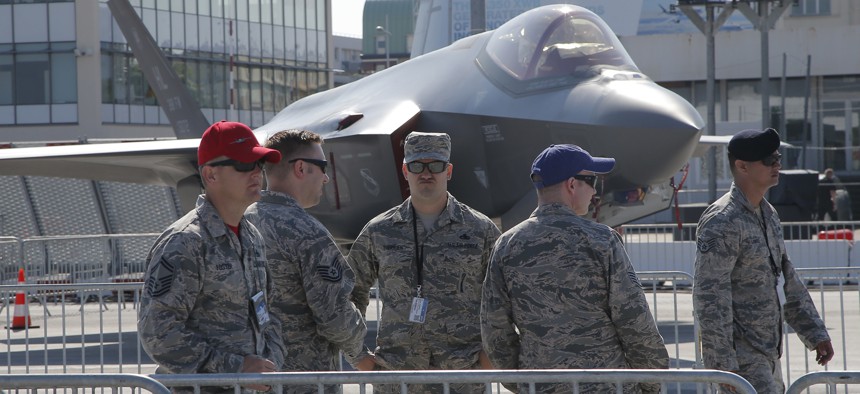
U.S. servicemen gather next to a F-35 Lightning II at Paris Air Show, on the eve of its opening, in Le Bourget, east of Paris, France, Sunday, June 18, 2017. Michel Euler AP
Global Demand for US Weapons 'Busier Than Ever' in Trump Era, So Far
Large American delegation at Paris Air Show reassures allies worried about disengagement.
LE BOURGET, FRANCE — The shift in U.S. presidential administrations has not affected the world’s demand for American-made weapons, Pentagon officials and industry executives said at the Paris Air Show.
“What I’m seeing is a global demand from our partners in air, space and cyberspace,” said Heidi Grant, who has been the Air Force’s deputy undersecretary for international affairs since 2010. “We’re busier than ever and people want the U.S. to be the partner of choice.”
Nor has the new administration changed how U.S. firms and the Pentagon are pitching American arms and other defense goods and services, Grant said. The United States boasted a sizable delegation at this year’s installment of the biennial Paris Air Show, one of the world’s largest military and aerospace events.
“Not only in Europe, but globally, I get that question, wondering: Have things changed the way we’re engaging our partners?” Grant said. “I haven’t witnessed any change in what I’m doing...I’m continuing to engage globally.”
It was a welcome sign for American defense firms and allies who had been waiting to see how the U.S. government presence at the biennial event would change under the Trump administration. After all Trump has often criticized allies for not paying their fair share for defense.
But at the show, officials touted the prospect of increased defense budgets, although legislative hurdles remain.
“There’s some very good energy,” said John Luddy, vice president for national security policy at the Aerospace Industries Association, the chief advocacy group for America’s defense and aerospace sector.
“This is kind of where the action is from a business-to-business context,” Luddy said. “[Companies] see the [budget] topline going up and they see all the demand signals in the United States going a certain direction.”
Meanwhile, other NATO nations are increasing their own defense spending, or planning to do so, in the wake of Russia’s annexation of Crimea and urging from Trump and other U.S. officials.
“The demand signal is increasing and that’s going to get everybody talking more,” he said. “I don’t think it’s anymore complicated than that, in terms of the buzz we’re talking about.”
Even though many political positions inside the Pentagon remain vacant, the U.S. government had a sizable presence at the show, headlined by Transportation Secretary Elaine Chao and Deputy Defense Secretary Bob Work. Numerous generals and admirals were in attendance, meeting with allies and defense firms.
A newish trend is the presence of delegations from American state governments, which have been investing in elaborate display booths to woo companies and new manufacturing facilities.
“It is the one place that I can bring the governor and she can meet every CEO of the major companies that we have in one place,” said Vince Howie, director of aerospace and defense for the Oklahoma Commerce Department.
On the federal side, U.S. officials were scheduled to hold bilateral meetings with European, Asian and Middle Eastern nations, a State Department official said days before the show started.
And the U.S. military has its own message for the firms at Paris: build new items on time and don’t break the bank.
“We’ve got to execute on these programs,” said Lt. Gen. Arnold Bunch, the U.S. Air Force military deputy for acquisition. “We’ve got to deliver what we say we’re going to at the prices we said we’re going to on the schedules.”
And they need to get better in three key areas. “We need to up our game” in software development, cyber security and cyber resiliency, meaning a machine’s ability to withstand an attack, Bunch said.
Air Force are also pushing defense firms to design new weapons for export.
“We’re seeing the trend that our partners and allies want the capability at the same time that we’re out there employing the capability,” Grant said. “We want them to be as capable as soon as they can.”
